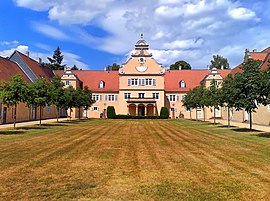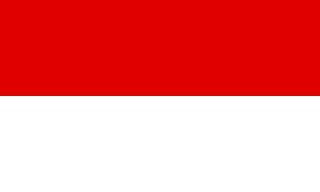
Hesse or Hessia, officially the State of Hesse, is a state in Germany. Its capital city is Wiesbaden, and the largest urban area is Frankfurt, which is also the country's principal financial centre. Two other major historic cities are Darmstadt and Kassel. With an area of 21,114.73 square kilometers and a population of over six million, it ranks seventh and fifth, respectively, among the sixteen German states. Frankfurt Rhine-Main, Germany's second-largest metropolitan area, is mainly located in Hesse.

Darmstadt is a city in the state of Hesse in Germany, located in the southern part of the Rhine-Main-Area. Darmstadt has around 160,000 inhabitants, making it the fourth largest city in the state of Hesse after Frankfurt am Main, Wiesbaden, and Kassel.

Darmstädter Ferienkurse is a regular summer event of contemporary classical music in Darmstadt, Hesse, Germany. It was founded in 1946, under the name "Ferienkurse für Internationale Neue Musik Darmstadt", as a gathering with lectures and concerts over several summer weeks. Composers, performers, theorists and philosophers of contemporary music met first annually until 1970, and then biennially. The event was organised by the Kranichsteiner Musikinstitut, which was renamed Internationales Musikinstitut Darmstadt (IMD). It is regarded as a leading international forum of contemporary and experimental music with a focus on composition. The festival awards the Kranichsteiner Musikpreis for performers and young composers.

Louis, Prince of Hesse and by Rhine was the youngest son of Ernest Louis, Grand Duke of Hesse by his second wife, Princess Eleonore of Solms-Hohensolms-Lich. He was a great-grandson of Queen Victoria.
Donatus, Prince and Landgrave of Hesse is the head of the House of Brabant and the German House of Hesse. He is the eldest son and successor of German aristocrat Moritz, Landgrave of Hesse, and his former wife, Princess Tatiana of Sayn-Wittgenstein-Berleburg. A great-grandson of Victor Emmanuel III of Italy, he is named in part after Georg Donatus, Hereditary Grand Duke of Hesse. He is also a descendant of Queen Victoria of the United Kingdom, and of Frederick III, German Emperor. He is a distant cousin of Prince Philip, Duke of Edinburgh, whose funeral he attended. The two are related through the Duke's British-born mother and a Princess of Battenberg by birth, Princess Andrew of Greece and Denmark, and the marriages of Philip's sisters Cécilie and Sophie into the House of Hesse. Donatus also attended the state funeral of Queen Elizabeth II at Westminster Abbey, London, on 19 September 2022 with his wife, Floria.

A Jagdschloss is a hunting lodge in German-speaking countries. It is a schloss set in a wildlife park or a hunting area that served primarily as accommodation for a ruler or aristocrat and his entourage while hunting in the area.

Bergpark Wilhelmshöhe is a landscape park in Kassel, Germany. The area of the park is 2.4 square kilometres, making it the largest European hillside park, and second largest park on a hill slope in the world. Construction of the Bergpark, or "mountain park", began in 1689 at the behest of the Landgraves of Hesse-Kassel and took about 150 years. The park is open to the public today. Since 2013, it has been a UNESCO World Heritage Site because of its monumental Baroque architecture and its unique fountains and water features.
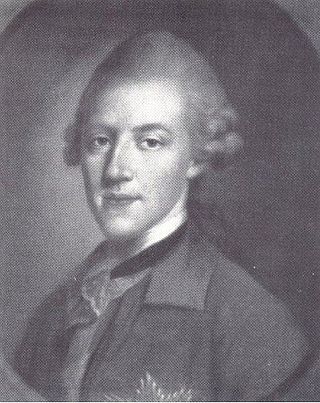
Frederick V Louis William Christian, Landgrave of Hesse-Homburg was from 1751 to his death landgrave of Hesse-Homburg.

Hessisches Landesmuseum Darmstadt (HLMD) is a large multidisciplinary museum in Darmstadt, Germany. The museum exhibits Rembrandt, Beuys, a primeval horse and a mastodon under the slogan "The whole world under one roof". As one of the oldest public museums in Germany, it has c. 80,000 visitors every year and a collection size of 1.35 million objects. Since 2019, Martin Faass has been director of the museum. It is one of the three Hessian State museums, in addition to the museums in Kassel and Wiesbaden. Similar institutions in Europe are the Universalmuseum Joanneum in Graz and the National Museum of Scotland in Edinburgh.
Louis Remy de la Fosse was a French architect during the Baroque period, who worked primarily in Germany. Until 1705, he was draftsman in the studio of master builder Johann Friedrich Eosander in Berlin. From 1706 to 1709, Fosse was architect at the court of Elector Georg Ludwig in Hanover and later castle planner in Schlitz and Kassel. From 1711 to 1714 he was court architect in Hanover and afterwards senior engineer in the service of Ernest Louis, Landgrave of Hesse-Darmstadt. In 1717, he build the Orangerie in Darmstadt. Fosse was commissioned to completely redesign the Residential Palace Darmstadt. Due to lack of funds, only the main front and one wing of the large complex were realized.

The Stadtkirche Darmstadt is the main Protestant church of the city of Darmstadt and one of its parish churches, but no longer the bishopric seat of the local Evangelische Kirche in Hessen und Nassau, which is the Pauluskirche in Darmstadt.
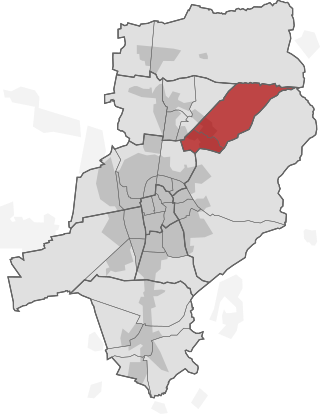
Kranichstein is a district in the city of Darmstadt. The town started with housing construction in the 1960s and now also has a number of residential high-rises. Often referred to as Darmstadt-Kranichstein.

Schloss Holzheim is a former hunting seat of the ruling family of Hesse-Kassel, located in the village of Holzheim in the German state of Hesse, approximately 80 kilometres (50 mi) south of Kassel. The hunting lodge was built between 1732 and 1735 under Frederick I, King of Sweden and also Landgrave of Hesse-Kassel, in baroque style on the medieval foundation walls of the former manor house of the local noble families Von Holzheim and Von Romrod. Frederick's father, Landgrave Charles I, Landgrave of Hesse-Kassel had often come here for hunting. Frederick's brother and governor, Prince William, liked to be here as well because of the rich game population of the forest areas around the princely estate.

Bad Homburg Castle is a castle and palace in the German city of Bad Homburg vor der Höhe. Originally the residence of the Landgraves of Hesse-Homburg, it was first built in the 12th century. All but the keep was demolished in 1660 by Frederick II, Landgrave of Hesse-Homburg. He replaced the old castle with a new one designed by Paul Andrich between 1680 and 1685. Its grounds and gardens were landscaped in the 18th and 19th centuries, including the addition of the Gothic House.
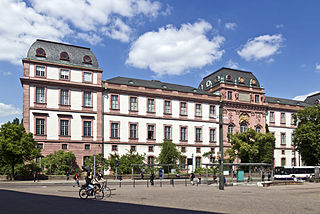
The Residential Palace Darmstadt is the former residence and administrative seat of the landgraves of Hesse-Darmstadt and from 1806 to 1919 of the Grand Dukes of Hesse-Darmstadt. It is located in the centre of the city of Darmstadt. The palace consists of an older Renaissance part and an 18th century Baroque part.

Wolfgang Steinecke was a German musicologist, music critic, and cultural politician. In Darmstadt, he revived cultural life after World War II, especially by initiating the Darmstädter Ferienkurse, which connected Germany to the international scene of contemporary music.
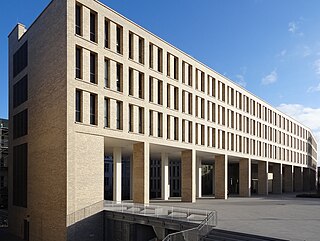
The University and State Library Darmstadt supplies literature and information for members of the Technische Universität Darmstadt and the population of Darmstadt and southern Hesse. Purposes of the institution include education, research and teaching. As of 2021, the library has a stock of 4,756,277 publications with an annual circulation of 354,200; ULB has 220,000 visitors and employs a staff of 103.66 FTE. The ULB offers at three locations learning rooms and spaces for over 1000 people. As of 2023, the City Centre library opened 24 hours per day. Director is Thomas Stäcker. ULB Darmstadt is member of the Hessisches BibliotheksInformationssystem (hebis).
Johann PeterBoßler [ˈbɔslɐ] also written Bossler and Bosler was a German master gunsmith and hunting arms manufacturer. He was in the service of the House of Hesse-Darmstadt and is considered an outstanding figure in the history of hunting in Hesse-Darmstadt.
Friedrich Jacob Boßler [ˈbɔslɐ] also written Bossler and Bosler were a German master gunsmith and airgun maker of the 18th century.
